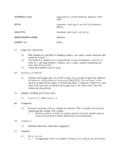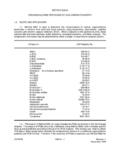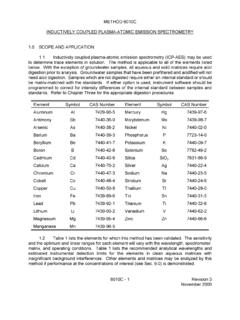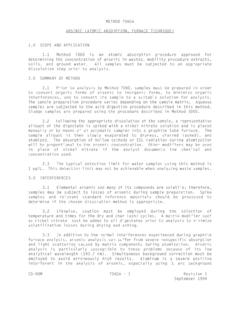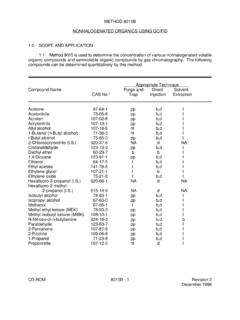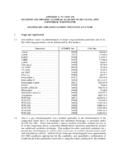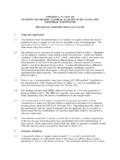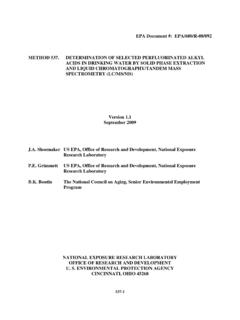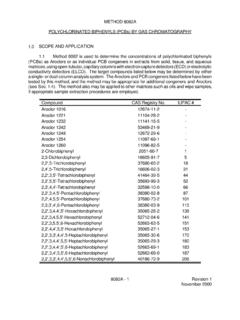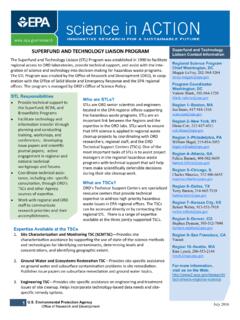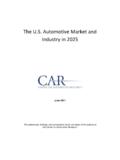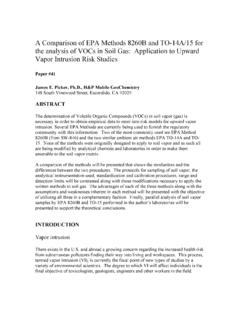Transcription of METHOD 314.0 CHROMATOGRAPHY Revision 1.0 …
1 1 METHOD DETERMINATION OF PERCHLORATE IN DRINKING WATER USING IONCHROMATOGRAPHYR evision 1999 Daniel P. Hautman and David J. Munch, US EPA, office of Ground Water and Drinking WaterAndrew D. Eaton and Ali W. Haghani, Montgomery Watson LaboratoriesNATIONAL EXPOSURE RESEARCH LABORATORYOFFICE OF RESEARCH AND ENVIRONMENTAL PROTECTION AGENCYCINCINNATI, OHIO 452682 METHOD DETERMINATION OF PERCHLORATE IN DRINKING WATER USING IONCHROMATOGRAPHY AND APPLICATION METHOD covers the determination of perchlorate in reagent water, surface water,ground water, and finished drinking water using ion CHROMATOGRAPHY . single laboratory reagent water METHOD Detection Limit (MDL, defined in ) for the above analyte is listed in Table 1. The MDL for a specific matrix maydiffer from those listed, depending upon the nature of the sample and the specificinstrumentation employed. order to achieve comparable detection limits, an ion chromatographic systemmust utilize suppressed conductivity detection, be properly maintained, andmust be capable of yielding a baseline with no more than 5 nanosiemen (nS)noise/drift per minute of monitored response over the background conductivity.
2 METHOD is recommended for use only by or under the supervision of analystsexperienced in the use of ion CHROMATOGRAPHY and in the interpretation of the resultingion chromatograms. this METHOD is used to analyze unfamiliar samples for perchlorate, anionidentification should be supported by the use of a laboratory fortified matrix sample. The fortification procedure is described in Section of the METHOD data should identify data quality objectives prior to analysis. Usersof the METHOD must demonstrate the ability to generate acceptable results, using theprocedures described in Section METHOD specifies an IC column and analytical conditions which were determinedto be the most effective for the widest array of sample matrices. Other IC procedureshave been written which incorporate similar columns and conditions, such as hydroxidebased mobile phases, low hydrophobicity IC columns, and measurement by suppressed conductivity During the development of this METHOD , these otherprocedures, as well as the columns and conditions outlined in this METHOD , wereconcurrently investigated with comparable results for test matrices with moderate levelsof common inorganic background anions.
3 These findings were consistent with those ofthe Inter-Agency Perchlorate Steering Committee, Analytical Subcommittee s Report,6published in 1998, which reported on the results of an interlaboratory validation of3 these other Ion Chromatographic Methods. The columns and conditions identified inthis METHOD were recommended since they bore the greatest tolerance for the highestlevels of common inorganic anion interference. OF METHOD mL volume of sample (see Note), is introduced into an ion chromatograph (IC). Perchlorate is separated and measured, using a system comprised of an ionchromatographic pump, sample injection valve, guard column, analytical column,suppressor device, and conductivity :This large sample loop ( mL) can be made using approximately 219 cm (86inches) of inch PEEK tubing. The exact volume is not critical sinceall standards and samples will use the same sample loop. However, thevolume should be verified to be within 5% of this volume by weighing thesample loop empty, filling the loop with deionized water and re-weighing theloop.
4 The volume can then be approximated by assuming the density of wateris mg/uL. BATCH -- A sequence of samples, which are analyzed within a 30 hourperiod and include no more than 20 field samples. An Analysis Batch must alsoinclude all required QC samples, which do not contribute to the maximum field sampletotal of 20. The required QC samples include: Instrument Performance Check Standard (IPC) Laboratory Reagent Blank (LRB) Initial Calibration Check Standard (ICCS) Laboratory Fortified Blank (LFB) Continuing Calibration Check Standard (CCCS), when the batch contains more than10 field samples End Calibration Check Standard (ECCS) Laboratory Fortified Matrix (LFM) Either a Field Duplicate, a Laboratory Duplicate or a duplicate of the LFM (if pretreated samples are included in batch) Pretreated LRB (if pretreated samples are included in batch) Pretreated LFB (if pretreated samples are included in batch) Pretreated LFM, for each :Every field sample analysis, including both diluted and pretreated fieldsamples, but excluding any LFM or duplicate field sample analysis whichqualify as QC samples, must be applied to the maximum of 20 total fieldsamples permitted in an analysis field sample(s), included in the analysis batch, can be reanalyzed following the ECCS provided the 30 hr time limit for the analysis batch has not laboratory can reanalyze that sample(s) but must initially conduct a second ICCS before the reanalysis and an ECCS after the final reanalysis.
5 The ECCS must be completed within the 30 hr STANDARD (CAL) -- A solution prepared from the primary dilutionstandard solution(s) or stock standard solutions. The CAL solutions are used tocalibrate the instrument response with respect to analyte concentration. CALIBRATION STANDARDS -- A series of CAL solutions used to initiallyestablish instrument calibration and develop calibration curves for individual targetanions (Section ). CALIBRATION CHECK STANDARD (ICCS) -- A CAL solution, which isanalyzed initially, prior to any field sample analyses, which verifies the previouslyestablished calibration curve. The concentration for the initial calibration checkstandard MUST be at or below the MRL (Section ) CALIBRATION CHECK STANDARDS (CCCS) -- A CAL solutionwhich is analyzed after every tenth field sample analyses, not including QC samples,which verifies the previously established calibration curve and confirms accurateanalyte quantitation for the previous ten field samples analyzed.
6 The concentration forthe continuing calibration check standards should be either at a middle calibration levelor at the highest calibration level (Section ). CALIBRATION CHECK STANDARD (ECCS) -- A CAL solution which isanalyzed after the last field sample analyses which verifies the previously establishedcalibration curve and confirms accurate analyte quantitation for all field samplesanalyzed since the last continuing calibration check. The end calibration check standardshould be either the middle or high level continuing calibration check standard ( ). DUPLICATES (FD) -- Two separate samples collected at the same time andplace under identical circumstances and treated exactly the same throughout field andlaboratory procedures. Analyses of field duplicates indicate the precision associatedwith sample collection, preservation and storage, as well as with laboratory procedures. PERFORMANCE CHECK SOLUTION (IPC) -- A solution containinga specific concentration of perchlorate and other test substances (namely chloride,sulfate and carbonate) used to evaluate the performance of the instrument system withrespect to a defined set of DUPLICATE (LD) -- Two sample aliquots (LD1 and LD2), taken inthe laboratory from a single sample bottle, and analyzed separately with identicalprocedures.
7 Analyses of LD1 and LD2 indicate precision associated specifically withthe laboratory procedures by removing variation contributed from sample collection,preservation and storage FORTIFIED BLANK (LFB) An aliquot of reagent water, or otherblank matrix, to which a known quantity of perchlorate is added in the laboratory. TheLFB is analyzed exactly like a sample, and its purpose is to determine whether themethodology is in control, and whether the laboratory is capable of making accurate andprecise FORTIFIED SAMPLE MATRIX (LFM) An aliquot of anenvironmental field sample to which a known quantity of perchlorate is added in thelaboratory. The LFM is analyzed exactly like a sample, and its purpose is to determinewhether the sample matrix contributes bias to the analytical result (when compared tothe result for the LFB). The background concentrations of perchlorate, in the samplematrix, must be initially determined in a separate aliquot and the measured value in theLFM corrected for this background REAGENT BLANK (LRB) An aliquot of reagent water or otherblank matrix that is treated exactly as a sample including exposure to all glassware,equipment, solvents, filtration and reagents that are used with other samples.
8 The LRBis used to determine if perchlorate or other interferences are present in the laboratoryenvironment, the reagents, or the CALIBRATION RANGE (LCR) The concentration range over which theinstrument response is SAFETY DATA SHEET (MSDS) Written information provided byvendors concerning a chemical's toxicity, health hazards, physical properties, fire, andreactivity data including storage, spill, and handling CONDUCTIVITY THRESHOLD (MCT) The highest permittedconductance of an unknown sample matrix, measured prior to conducting the analysis,which is used to determine when sample matrix dilution or pretreatment is required. The conductance of a sample matrix is proportional to the common anions present inthe matrix (which contribute to the level of total dissolved solids [TDS]) which cangreatly affect the integrity of this analysis. The value for this threshold is dependant onthe conditions, hardware, and state of the hardware employed. Consequently, thisthreshold is not METHOD defined and must be determined by the individual analyticallaboratory during the Initial Demonstration of Capability (IDC) and confirmed in eachanalysis batch using the Instrument Performance Check (IPC) Solution.
9 Matrix6 conductivity is measured in microsiemens/cm (uS/cm) or microMhos/cm (uMhos/cm)which are considered equivalent terms. DETECTION LIMIT (MDL) The minimum concentration of an analytethat can be identified, measured and reported with 99% confidence that the analyteconcentration is greater than , REPORTING LEVEL (MRL) The minimum concentration that can bereported as a quantitated value for a target analyte in a sample following analysis. Thisdefined concentration can be no lower than the concentration of the lowest calibrationstandard and can only be used if acceptable quality control criteria for this standard AREA TO HEIGHT RATIO (A/H) The ratio of the peak area divided by thepeak height which is used as a tool to monitor analytical performance. This ratio isused to establish and monitor the MCT and represents an objective means of assessinganalytical performance when analyzing high conductivity matrices. A gradualdistortion of the baseline is typically observed in the retention time window forperchlorate as the matrix conductivity increases (consistent with elevated levels ofcommon anions) which will more significantly influence peak height relative to theinfluence on peak area.
10 As the distortion of the baseline increases, this ratio increases,and the integrity of the measured perchlorate will be compromised. TESTING (PT) or PERFORMANCE EVALUATION (PE) SAMPLE -- A certified solution of METHOD analytes whose concentration is unknown to theanalyst. Often, an aliquot of this solution is added to a known volume of reagent waterand analyzed with procedures used for samples. Often, results of these analyses areused as part of a laboratory certification program to objectively determine thecapabilities of a laboratory to achieve high quality CONTROL SAMPLE (QCS) A solution of METHOD analytes of knownconcentrations that is obtained from a source external to the laboratory and differentfrom the source of calibration standards. It is used to check laboratory performancewith externally prepared test STANDARD SOLUTION (SSS) -- A concentrated solution containingperchlorate which is either prepared in the laboratory using assayed reference materialsor purchased from a reputable commercial DISSOLVED SOLIDS (TDS) -- Both organic and inorganic constituent whichare dissolved in a sample matrix and are not removed by particulate filtration.
